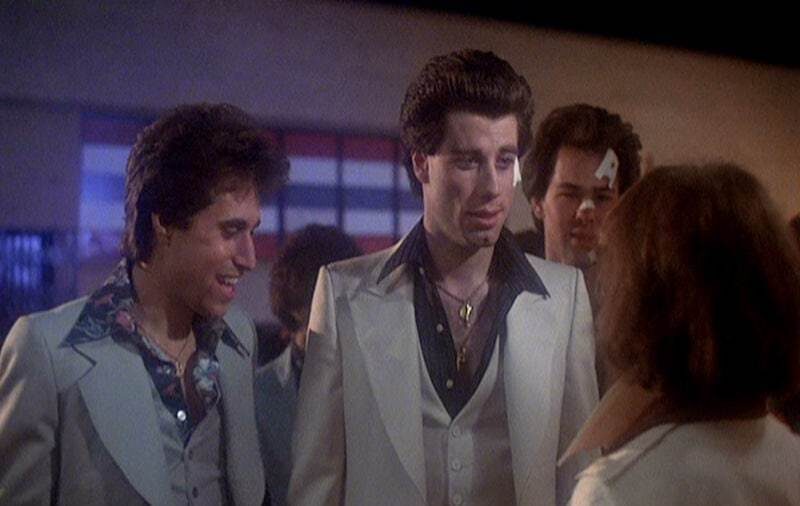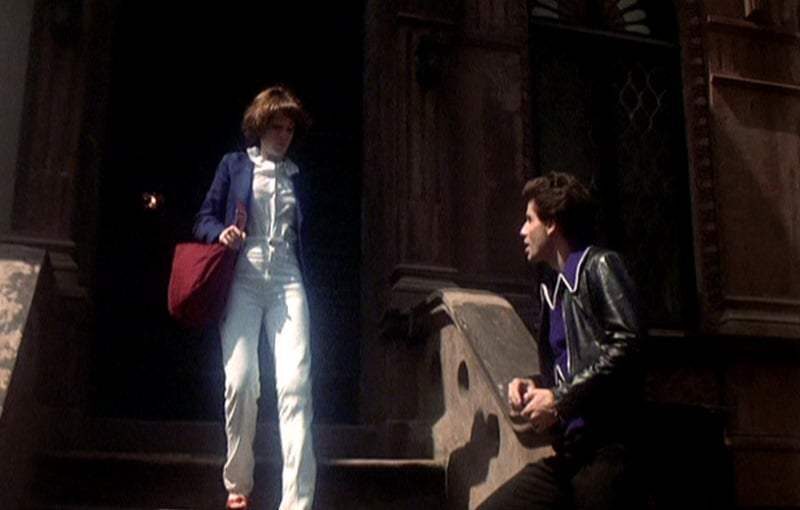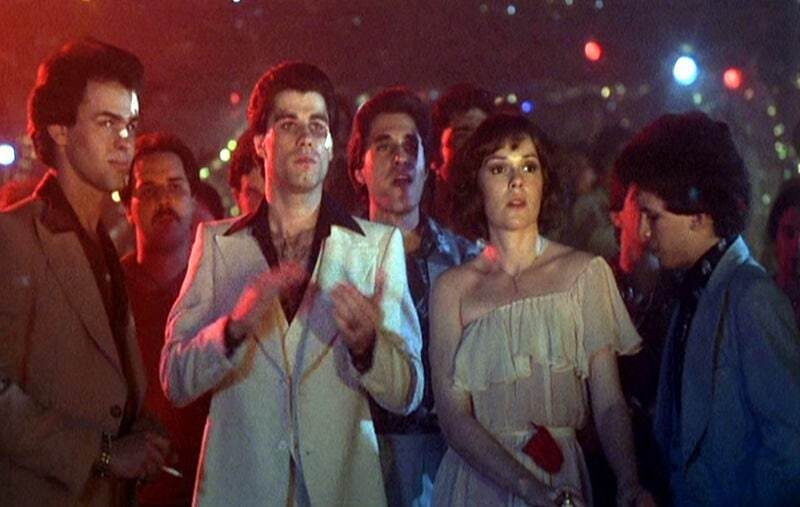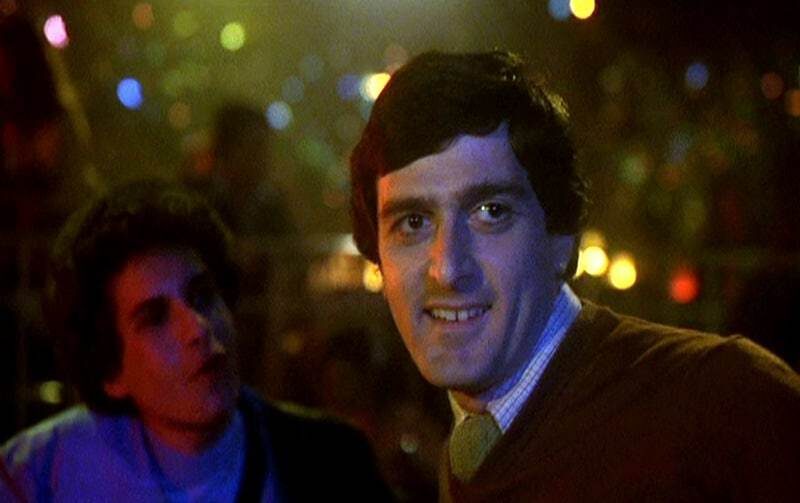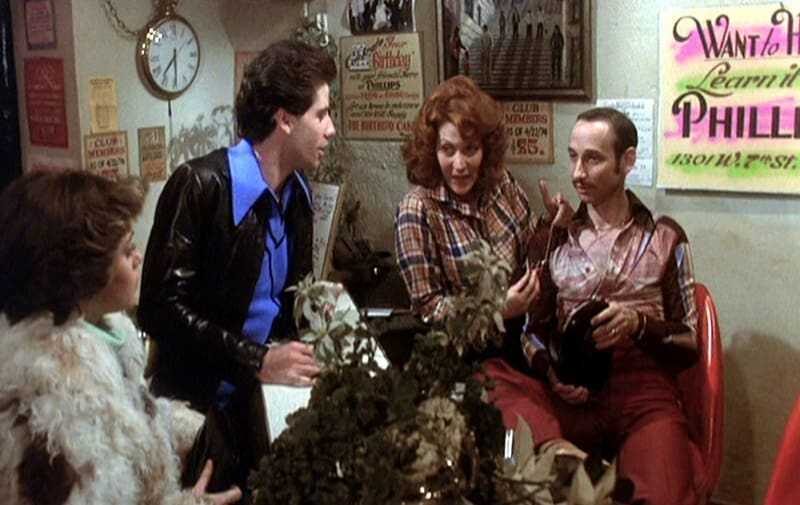Dual Analysis: Saturday Night Fever | Clothes on Film
Establishing a new feature at Clothes on Film called Dual Analysis, the following review is written in collaboration with costume designer Kristin M. Burke (Death Sentence, Crossing Over); the intention being to provide a deeper, more balanced analysis of the film in question. For a detailed synopsis of the plot from Saturday Night Fever (1977), visit Kristin’s own site Frocktalk.
Kristin’s Thoughts:
I love this movie. It is so dark, and at the time it was released, taped into the zeitgeist of a large, young part of our population. In a post-hippie reality, with a culture embracing its own diversity at last, along comes a movie that talks about all of it. In Saturday Night Fever, we find forums for discussion about everything from women’s lib to racism – hot topics at the time – and yes, these issues are carried out, expressed and explored in the costumes.
First we have Tony Manero himself – sex on a stick, basically. Here is a guy who is a walking hormone. Italian, Italian, Italian. Macho, macho, macho. We first meet him in a silhouette and a look that we see repeated throughout the film. It consists of Angel’s flight pants (a disco staple), a collared shirt with the collar worn outside the coat lapels, unbuttoned to reveal gold chains and chest hair, a coat, and some heeled dance shoes. His change 1 look consists of a black leather jacket, with black pants, a red shirt and shiny red shoe boots. He kind of looks like a black widow spider.
A note about the Angel’s Flight pants – as mentioned, these were a disco staple. They were made out of polyester, and they were quite tight in the buttocks, tight in the crotch, and flared at the hem. Polyester – it doesn’t breathe well. Imagine dancing, getting all sweaty, in polyester.
As Tony gets ready for the club, he wears a different combo – pinkish disco pants, a print shirt (with some pink in it), and a red leather jacket. Still with the gold chains and the big shoes. He dances without his coat, and look at these fabulous lines – high waisted pants make the legs look so much longer in this case. Note the print on the shirt – it’s kind of dreamy and feminine. He is letting his macho guard down here when he falls for Stephanie.
Later in the film, we see him in changes similar to change 1 – this time, it’s with a Banlon. His costume pieces may be different, but the effect is the same. His silhouette stays consistent throughout the film.
When we get to the big dance competition, he appears in the white 3-pc suit with black shirt. This is the signature, iconic look of the film; so iconic, in fact, was this look that it was parodied in the movie Airplane and by the Muppets, and has become a top-selling Halloween costume.
Tony Manero’s costumes arc from dark to light. In the end of the film, when he has an epiphany and realizes he needs to change his life, he is in white. He starts out black, unenlightened. He ends up in white, having had an epiphany, and breaking free.
Stephanie brings us some interesting costumes as well. For the first half of her time in the film, she is in white or pale pink. No one else in the film wears white to the extent she does. She is a city girl (at least she works in the city) living in Brooklyn. A daisy among weeds, if you will (and I’m not saying Brooklyn is weeds, I’m just putting it into metaphoric perspective in Tony Manero’s eyes). The first time we see her, at the disco, it is a white jersey dress. It’s a feminine look, almost 1930s if you think about it, and the flowers add a delicate, vulnerable touch.
We then see her at the dance studio, doing ballet stretches in her leotard. Pale, pale pink. This is when she rebukes Tony. We see her again at the dance studio, another day, in a similar leotard, pale, pale pink, but with a shirt tied around her.
Tony and Stephanie go to coffee and she blathers on about how important her job is. Note the light color of her trench. As she sips her tea, and tries to talk about Zeferelli, even under her cream colored trench, she is still in pale pink.
In her first real rehearsal with Tony, she wears a blue leotard to his red ensemble. I thought of this as separating these two characters using color. They are distinctly different. The use of color on Stephanie could symbolize her reaching out to Tony, to his world. This is the first time we’ve seen her in a color.
When Tony helps her move to the city, she wears a fussy white blouse with white pants, and a blue cardigan. If blue represents “Brooklyn” in some respect to her, and the white represents her own citified enlightenment, then the costume (which has her wearing pants for the first time) shows her taking control of her life. She can remove the blue sweater and be done with Brooklyn for good.
Waiting for Tony at 2001: Odyssey on the night of the dance competition, she wears the cream trench again, though it looks pink because of the lighting. Here she is a city girl (white) back in Brooklyn. Her chiffon scarf is nicer than anything the other girls would have there.
Her final dance costume is a one-shouldered chiffon number, it appears. This is the classic disco style. It makes me wonder what kind of bra she was wearing for support. But then again, they weren’t doing any kinds of crazy moves. Maybe the jiggle was minimal.
The costume is as pale as can be – I am pretty sure that the cause of all of these pale costumes is the “enlightenment of the city, daisy-among-weeds” thing. In the end, when she lets Tony in to her Manhattan apartment, she wears… a white bathrobe. It’s simple, and it brings her color palette and Tony’s color palette together for the first time. They are both enlightened.
Annette has some beautifully unfortunate costumes. The first time we meet her, it’s in the dance club. She wears this chartreuse-colored dress; it looks to be a wrap-dress, or surplice top at minimum, in some kind of jersey fabric. Could be polyester, it’s hard to tell. It has a floral detail on the left shoulder and right hip. It also has a vintage feel to it, maybe slightly 1940s. The color is significant to me, because I don’t consider chartreuse to be particularly sexy or attractive. The use of this color on Annette is a nice way to try to convince the audience of that, as well.
The rest of the movie is spent, for her, in more colors like baby blue, light green, and grey, mostly covered up by this huge fur coat. I remember this coat most distinctly from seeing the movie years ago; even more than the white suit. It made a huge impression on me.
The actress is so short, it looked out of proportion with everything she was wearing. I like that it works against her. It’s right for the character. We need to feel sorry for Annette.
Speaking of girls we can feel sorry for, here is Doreen. Her costume is interesting because it hearkens back to a time when women were beholden to men. Her behavior (wiping the sweat from Tony’s brow) echoes this sentiment. I think it is smart to dress Doreen in a garment that looks like a throwback. Further, her hair is TRAGIC. Great job, hair department.
Frank Jr. has some interesting costume changes happening. He greets Tony, wearing his priest dickie over a t-shirt. These are the last vestiges of his former occupation. After this, he will never wear them again. However, it is important that the audience sees him like this.
We then see Frank Jr. at the nightclub, wearing a v-neck sweater, dress shirt and clunky tie. He is so out of place there; the costume really serves the story.
His final costume change is when he tells Tony to find his own path in life. Here, Frank Jr. looks more like a college student than former priest. Note the button-down collar and chunky cardigan. He’s clean-cut, and off to start a new life.
Tony’s mother (I think her name is Flo in the movie, but it’s never mentioned) has some great housedresses and house clothes. Take a look at her here, when Tony comes home from work. She is giving him a “B*tch, please” look. She is fantastic.
The costume when Frank Jr. didn’t come home for dinner. It’s so fabulously prim; her heartbreak is magnified in this sad, matronly garment.
Now, on to Bobby and the boys (Gus, Joey and Double J). Bobby, it should be noted, wears platform shoes during the duration of the film:
They are very, VERY high.
In the scene, however, when he falls off the bridge, you can clearly see that it is a stuntman wearing sneakers. I won’t put a picture of it on here, but search for yourself. It would have been totally unsafe for a stuntman to wear platforms that high for a stunt so dangerous. It just bears a mention that sometimes what looks like a “mistake” is just a costume situation that can’t be overcome due to safety.
The boys wear versions of the same costumes, just individually tailored to their body types and looks:
One thing in common – leather jackets. Oh yes, and tight pants.
They go for the same sleek disco shirts as Tony, but fail to arrive at his level of “cool”. The costumes on these boys are brilliant, though, in that they unify these boys as a group.
Pete, the dance studio owner – you just have to see him. It’s like someone hit John Waters with the 1970s stick. I love it.
And the Puerto Rican dance team – they really had some flair and “cha cha” in their dance costumes. I love these dance costumes – it heightened the dance itself in the way the fabric moved. Lovely.
I think that the film in general captures a moment in history beautifully. People actually looked like this in the clubs, as hard as it may be for a young person these days to understand. No one laughed at how big the collars were. This was for real.
Certainly the film looks East Coast to my eyes. We didn’t have as much use for cold-weather gear in California, and for the most part, California was still drowning in hippie culture in 1976 – 1977. I love this film as a reference for disco. I also love it because its subject matter is haunting and timeless. I hope you enjoy the film, and its iconic costumes!!
Chris’ Thoughts:
Sleazy sex, drugs, violence, foul language, rape, racism, homophobia, suicide – if you only remember Saturday Night Fever for its Bee Gees soundtrack and lurid fashions you are in for a serious wake up call. This is one of the bleakest, yet most compelling movies of the seventies.
As the opening credits roll, young Italian-American dude Tony Manero (John Travolta) struts through Brooklyn in his bell bottom slacks and cropped leather coat like an urban cowboy on a mission; the new frontiersman with only three things on his mind: dancing, women, getting the hell out of Dodge.
Seconds before we are introduced to Tony the camera pans across Brooklyn Bridge from Manhattan, down into the tough streets of Bay Ridge. Tony has a way to go in pursuit of the American Dream, not in terms of miles but in abandoning his juvenile gang lifestyle, necessary if he ever wants to fit into the supposedly sophisticated world of New York.
When Tony meets Stephanie (Karen Lynn Gorney) a local girl now working in Manhattan, she immediately gets his number, cutting “You’re nowhere on your way to no place”. Though stuck up and phony, Stephanie has a point. Along with his brother quitting the church this is a catalyst moment for Tony. It stings, but he knows that to get somewhere in life he actually has to do something.
With the story drawing to a close Tony has apparently proven Stephanie wrong; he hopes to build a new life in Manhattan. Yet, sequel notwithstanding, it is difficult to believe he could ever really succeed outside his comfort zone of big fish in a small pond. Tony certainly has aspirations, but he would rather dream the dream than live it.
Costumer Designer Patrizia Von Brandenstein created a look for Saturday Night Fever that is arguably only remembered for one outfit: Travolta’s white 3 piece suit.
However there is more at work here than an iconic poster image. Von Brandenstein (who would later become a production designer) deftly matched all costumes to their environment. Whether it’s the synthetic shirts worn by Tony on the dance floor or the drab knitwear of the old folks; the fakery of disco against the honest misery of a generation lamenting the young for rejecting a future they so bleakly promote.
According to the film’s director John Badham, for budget and authenticity reasons every costume was sourced and not made.
Disco wear drew influence from early seventies glam rock and even gangster flamboyance of the 1930s. Applying to both male and female, this includes Stephanie’s trenchcoat and tweed cap, Tony’s white suit with two-tone brogues, Annette’s (Donna Pescow) short fur jacket, the Grecian-esque gowns, tightly cuffed pyjama pants, and billowy sleeved shirts. As a mass produced version of pimp wear (from Blaxploitation films such as Shaft, 1971 and Coffy, 1973) it was, to rephrase the moustachioed DJ in Brooklyn’s Club 2000, the ‘polyester look’ of the day.
By making costume uniform, Von Brandenstein ensured every disco patron belonged implicitly to that scene, the girls and the guys. Tony and his crew were especially concerned with their appearance (Tony as leader, of course, with his blow-dried hair and permanently spread shirt collars). They rigidly appropriated a specific look; a concept not fashionable for men since the mid-1960s. In affect, Tony and his crew were New York mods.
The disco scene however was not a clean one, far from it. Those fairytale-like dance routines in Saturday Night Fever, bathed in dry ice and flashing lights, represent hazy interpretation of the seventies’ last hurrah. Before the gallant optimism of new romantics, disco would disappear in a cacophony of drugs and casual sex. In many ways disco was filthier than punk; then came AIDS and the sixties hangover of free love and experimentation was gone for good.
This film is often credited as bringing disco to the masses, and yet for all the colourful costumes and up-tempo music, John Badham has crafted a dark journey into the prejudiced and hopeless side of inner-city life. It is an incredible achievement that improves with age. Though make no mistake, this is no fond inauguration into the musical sub-genre that defined a decade; Saturday Night Fever is the death of disco.
In Conclusion:
Following a lengthy chat with Kristin it was clear that we had covered similar ground in our reviews: dark side of disco, 1930s influence (especially for Stephanie), lingering iconic status of Tony’s suit, cultural/social divides in fashion.
Kristin hit upon the notion of shifting immigrant neighbourhoods inspiring sartorial trends; also she talked about the ‘Gunne Sax’ influence on Stephanie’s dress during the final dance number (ruffles, feminine and ‘wenchy’). Regarding Tony’s uniform silhouette of slim shirt, leather jacket and flares, Kristin went into detail explaining ‘Angel Flight Pants’ (polyester flared trousers, tight in the seat); helpful as the brand was not particularly well known in the UK.
All in all we both agreed that Saturday Night Fever is a seminal work of the era and that disco, despite its colourful camp reputation now, was actually far from family friendly in its late seventies heyday. – Chris
Read a full transcript of the chat at Frocktalk.
© 2009 – 2014, Lord Christopher Laverty.





